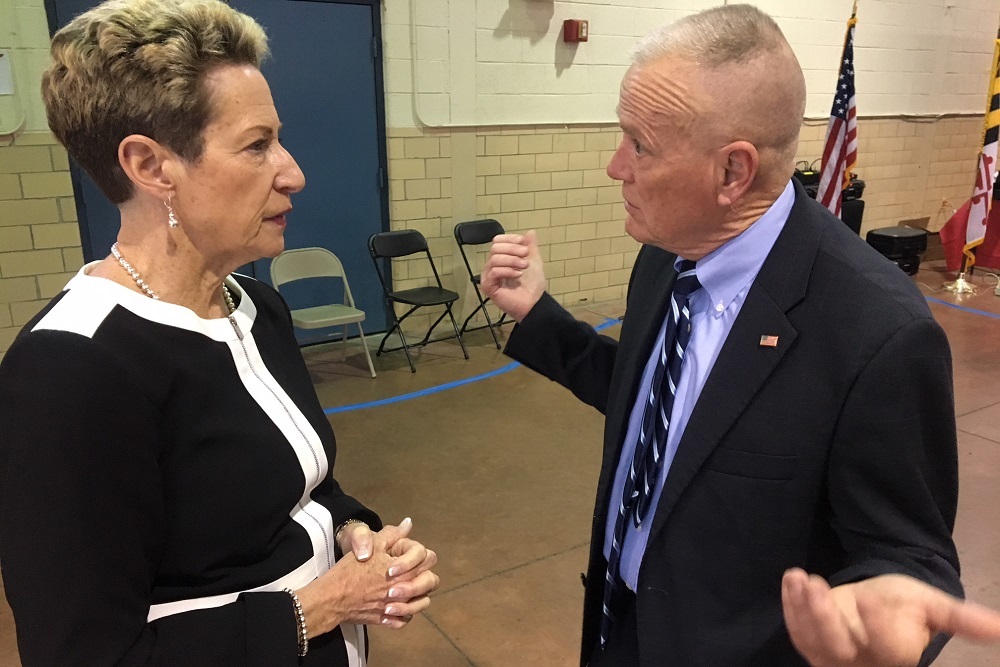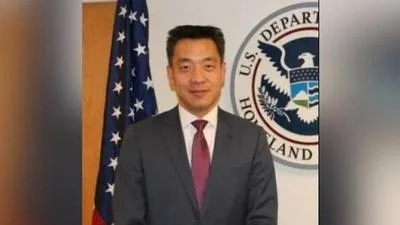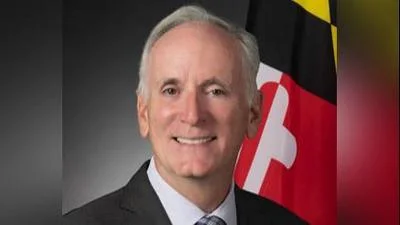Maryland Gov. Larry Hogan
Maryland Gov. Larry Hogan
Maryland schools that have applied for money to improve safety, the deadline for which passed earlier this week, followed certain guidelines in hopes of securing that funding, the director of a state center for school safety said.
Maryland's School Safety Subcabinet approved a notice of funding availability for round one of the fiscal year 2019 Safe Schools Fund Grants Program, Maryland Center for School Safety Executive Director Ed Clarke told the Maryland State Wire in an email interview.
"The Maryland Safe to Learn Act of 2018 Act created a Safe Schools Fund to provide grants to local school systems to enhance school safety," Clarke said.

Maryland Center for School Safety Executive Director Ed Clarke, right, with State Superintendent of Schools Dr. Karen Salmon chatting during a recent gathering.
| Photo courtesy of Maryland Center for School Safety
Round-one funding includes $2.5 million for completion of school safety assessments which need to be completed by the local school systems on or before June 15, 2019. It also includes $3.5 million for operational funding to satisfy the statutory mandates set forth in Section II of the notice of funding availability and in the Safe to Learn Act.
The deadline for districts to apply for round-one funding was Aug. 15. The closing deadline is Oct. 31.
The Maryland Center for School Safety, an independent unit of the state government established in 2013, works with local schools, law enforcement, government and community organizations, parents and others to promote safer schools.
In June, Gov. Larry Hogan announced $18.6 million in new education funding for initiatives and recommendations, including those made by Maryland's Commission on Innovation and Excellence in Education.
"Keeping our kids safe is one of our most important jobs," the governor said in a press release issued June 21 to coincide with the announcement of the new education funding. "This past session, we enacted landmark school safety legislation to create aggressive, statewide standards for school safety, expand the work of the Maryland Center for School Safety and require each school system in Maryland to develop assessment teams in order to identify potential safety threats."
The governor's office also is working to fund recommendations by the state's Commission on Innovation and Excellence in Education, commonly referred to as "the Kirwan Commission," which is informally named for its chairman, former University of Maryland System Chancellor William E. “Brit” Kirwan. Kirwan was named to that seat in August 2016 after the state General Assembly created the commission to examine how Maryland's public education is funded and how it can be improved.
The commission issued its preliminary report in January and a final report is expected at the end of the year.
Applications from school systems received by this week's deadline for fiscal year 2019 Safe Schools Fund Grants Program will be considered during School Safety Subcabinet meeting on Aug. 20, Clarke said. "Applications will be considered and approved on a rolling basis by the subcabinet at its regularly scheduled meetings," he said.
"Applications received between the subcabinet’s October meeting and the closing deadline of Oct. 31, 2018, will be considered at the subcabinet’s November meeting."
The Safe to Learn Act specifies eight school-safety-related areas for which a local school system may apply for a grant, Clarke said. "This allows each system to identify its needs in those areas of school safety and to submit a grant for consideration based on how school safety can be enhanced," he said.
"The Safe Schools Fund Grants Program allows the local system the opportunity to enhance school safety for their systems and schools."
School safety areas specified in the act include training on how to de-escalate safety situations, establishing ways to report safety concerns and improving and monitoring traffic control measures to reduce the potential for pedestrian and vehicle accidents.
"The center recommends that all schools take an all-hazard approach to school safety and emergency preparedness," Clarke said. "This includes the four phases of school emergency management: prevention/mitigation, preparedness, response and recovery. This approach also would include physical security, having a comprehensive school emergency plan, practice of emergency response drills, training, a positive school climate and culture and mental health awareness and support as well as other areas."






 Alerts Sign-up
Alerts Sign-up